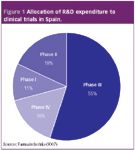News
Article
Pharmaceutical Technology Europe
Pharmaceutical Technology Europe
Will outsourcing reign in Spain?
Author(s):
Although overall pharmaceutical industry investment in R&D in Spain is growing at a slower annual level since 2004, investment in clinical trials remains strong.
Spain is a major European pharmaceutical market with an estimated value of €11.3 billion, according to the latest data from the European Federation of Pharmaceutical Industries Associations (EFPIA).1 IMS Health values Spain's retail pharmacy market at US$12.9 billion (€8.7 billion) and estimates that it grew by 8% between September 2006 and August 2007. Interestingly, according to these IMS data, the growth rate of Spain's retail pharmaceutical market during this period was higher than that of the US, Canada, UK, France, Germany and Italy.2,3

Figure 1
In terms of sales, the major therapeutic categories are cardiovascular, central nervous system (CNS), alimentary/metabolism and respiratory. Of these, the CNS area is proving popular — with sales having risen by 9% throughout 2006. Traditionally, antibiotics were considered to be a major product area, but sales in the anti-infectives class actually dropped by 3% in 2006.3
Demographic and greater coverage of the population by the nationalized health system have played an important part in the growth of the country's pharmaceutical market. In recent years, the government has attempted to slow expenditure on pharmaceuticals through cost-containment measures, but these have proven highly unpopular with the pharmaceutical industry and, if it reduces patient access to newly launched medicines, the government will not gain the support of the public.
A major demographic consideration that will drive further healthcare spending is the increase in the elderly population. The provision of healthcare for the elderly has become an important issue for industrialized countries, such as Spain, as the government shares much of the expenditure on medications. According to the Organization for Economic Cooperation and Development (OECD) those older than 65 years require four times as many healthcare resources as younger people.4 Spain is in a particularly difficult position as, by 2050, it is predicted to have one of the highest average-aged populations in the world.5 This rise, coupled with a decreasing national birth rate, will place greater pressure on the government to fund healthcare.
The pharmaceutical industry
Since 1985, the country has seen increasing investment from large, multinational pharmaceutical companies. This influx of investment is caused by Spain joining the EU and having implemented full patent protection on branded drugs. It is estimated that foreign companies now represent 75% of the country's pharmaceutical producers. Among the top ten leading the national market, only two are Spanish — Almirall Prodesfarma SA and Esteve SA.
A major attraction for multinational companies is Spain's location, which enables good access to a combination of European and Mediterranean countries. As part of the EU, where there is a free circulation of goods, it represents an ideal location for distribution to neighbouring Member States and beyond. This has been a key part of the strategy utilized by multinational companies that have invested in Spain. At present, the value of pharmaceutical exports from the country is €5.4 billion.2
However, its connections with other countries and its lower prices have also led to a rise in parallel trade within the EU. The pharmaceutical industry believes that the practice, which involves purchasing medicines at low prices in one Member State and their subsequent resale at higher prices in another, deprives it of valuable profits to fund R&D for new products. It is an issue that causes frequent legal battles between the pharmaceutical industry and parallel traders.
Recently, Almirall launched an ambitious plan to expand beyond Spain, presumably because of the intense competition in its home market and the difficulty in sustaining growth by relying solely on Spanish sales.6 The company already has subsidiaries in Belgium, France, Germany, Italy, Portugal and Mexico, but during the next 5–10 years, it will concentrate on the major regional markets to position itself as a pan-European company. It is hoping that aclidinium bromide, which is currently in Phase III trials for chronic obstructive pulmonary disease will help fuel this growth. In addition, Almirall acquired Hermal in September 2007 giving it a strong presence in dermatology in the German market.
R&D and outsourcing of clinical trials
In 2006, the Spanish pharmaceutical industry invested nearly €793 million in R&D.7 There has been some concern that the environment for pharmaceutical R&D in Spain is not as robust as it once was. Farmaindustria, an industry body representing pharmaceutical manufacturers, reported that R&D investment only grew by 3.6%.7 It notes that the growth in R&D investment at the beginning of the decade was closer to 20%, which suggests a substantial change in the environment for research. It believes that the government must do more to promote pharmaceutical R&D in and wishes to see better harmonization measures with the rest of the EU.
Although overall pharmaceutical industry investment in R&D in Spain is growing at a slower annual level since 2004, investment in clinical trials remains strong. Clinical trials, particularly Phase III, are accounting for an ever greater share of total R&D expenditure, and it is likely this trend will continue for the foreseeable future.
In 2006, €322 million was invested by the Spanish pharmaceutical industry in clinical trials, of which most was directed towards Phase III trials.7 There has also been increasing investment in Phase IV trials and postauthorization studies, which is starting to rival the level of investment in Phase II trials. In the same year, approximately €21 million was estimated to have been invested in pharmacovigilance studies. As regulators demand additional clinical data following approval of products, sponsors should expect to do more work in this area of clinical development.
From an outsourcing perspective, the competition between providers suggests that there is rising demand for their services. In a 2003 survey by Biomedical bioestatistic, 95.7% of Spanish pharmaceutical industry respondents utilized the services of CROs.8 In addition, 91.5% of those surveyed believed that the clinical trials market in Spain was still set to grow, with only 4.3% believing that it had plateaued.
As the Spanish government continues to introduce cost containment initiatives, pharmaceutical companies may turn to outsourcing providers to ensure their clinical trial programmes remain cost effective. As one of the top pharmaceutical R&D locations, the country is favoured when considering European clinical trial centres. In addition, its proximity to Portugal and links to Latin America have seen it being used by some CROs as a base to oversee trials further afield.
Most major CROs are now well-established in Spain, being concentrated around the major pharmaceutical centres of Madrid and Barcelona. At present, the main demand for CRO operational services centres on Phase III trials. According to Quintiles, of the 122 trials it has run in Spain and Portugal since 1996, 114 have been Phase III trials. Generally, the international clinical research community has had greater interest in using Spain for the later stages of the clinical trials process (Phase III-b and Phase IV). This is because of perceptions regarding bureaucracy, but an increasing number of sponsors have moved beyond this and are using the country earlier in their clinical development programmes. Improvements in the clinical trial approval process and greater familiarity with Spanish regulations have facilitated this trend.
There have been some concerns regarding the EU Clinical Trials Directive hampering clinical trials in Europe, and its implications for clinical research in Spain. The directive, which came into force in May 2004, was intended to create a harmonized framework for clinical drug research across Europe, but it continues to have its critics. At the 2007 European Cancer Conference, held in Barcelona, Dr Markus Hartmann, from European Consulting and Contracting in Oncology, suggested that there had been a decrease in the number of oncology clinical trials since the introduction of the directive.9 His findings suggested that Spain was being affected along with France, Germany, Italy, The Netherlands and the UK. However, the emphasis of these findings was on academic clinical trials rather than commercially sponsored ones. Currently, more than 80% of those clinical trials with Spanish centres on public registries are listed as industry-sponsored. From a Spanish perspective, the growth of the outsourcing market indicates that commercial sponsors are now beginning to get to grips with the finer points of the directive. Key to this growth will be the ability of outsourcing organizations to offer regulatory guidance and operational services when dealing with sponsors.
Compared with a decade ago, the country's outsourcing market can be considered fairly mature. As companies have increased their investment, their expectations of potential outsourcing partners has grown. Major sponsors will expect CROs to offer a full range of clinical trial services, from monitoring and project management through to regulatory affairs and quality assurance. Furthermore, many CROs are introducing new clinical trial offerings into the Spanish market such as web-based clinical trial management and metrics systems, and professional training and contract personnel services in line with the services they provide in other key markets.
References
1. European Federation of Pharmaceutical Industries Association, "The Pharmaceutical Industry in Figures" (2007). www.efpia.org
2. IMS Health, "IMS Retail Drug Monitor August 2007." www.imshealth.com
3. IMS Health, "IMS Retail Drug Monitor December 2006." www.imshealth.com
4. U-G Gerdtham et al., "Factors Affecting Health Spending: A Cross-Country Econometric Analysis in New Directions in Health Care Policies: Improving Cost Control and Effectiveness" (1995). www.oecd.org
5. BBC news, "Ageing Spain's Dilemma" (April 2002). http://news.bbc.co.uk
6. IMS Health, "Almirall goes public and steps out of Spain" (2007). www.imshealth.com
7. Farmaindustria, "Revista Farmaindustria NBA 9. Verano 2007." www.farmaindustria.es
8. PMFarma, "El Outsourcing se impone en los laboratorios farmacéuticos" (2003). www.pmfarma.com
9. European Cancer Conference, "Clinical Trials Directive still hampering academic medical research" (2007). www.ecco.org.eu
Newsletter
Get the essential updates shaping the future of pharma manufacturing and compliance—subscribe today to Pharmaceutical Technology and never miss a breakthrough.





